Federal Technology Transfer Act Success Stories

Successful Federal Technology Transfer Act (FTTA) partnerships demonstrate the many advantages of technology transfer and collaboration. EPA and partner organizations create valuable and applicable technologies for the marketplace.
External partners can use EPA’s high-quality research to develop new products and collaborate on additional research. EPA benefits from outside expertise, product development, and funding to develop solutions that can be rapidly applied to environmental problems. The public benefits from these agreements because new technologies reach the market quickly. Overall, successful FTTA partnerships further the goal of a cleaner, healthier environment.
- Removing Mercury, Arsenic and Other Metals from Contaminated Water Streams
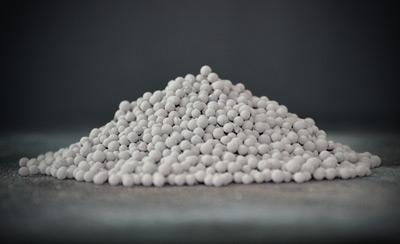 Sorbster media for removal of mercury, arsenic, and other metals from a contaminated waste stream.
Sorbster media for removal of mercury, arsenic, and other metals from a contaminated waste stream.MAR Systems and EPA partnered under a Cooperative Research and Development Agreement (CRADA) to investigate the reuse of spent catalysts from the Claus process. The Claus process is a final polishing step for light hydrocarbons to remove trace amounts of sulfur. The spent Claus catalysts have historically been disposed.
The researchers used the spent Claus catalysts to remove soluble metal contaminants from contaminated water streams.
The collaboration has continued through an exclusive license to MAR Systems for commercialization. The technology has been developed into a media, called Sorbster. MAR Systems manufactures Sorbster and uses it to treat the following in waste water streams at pH 3-12:
- Mercury
- Selenium
- Arsenic
- Other metals
This includes treatment of contaminated water streams, ground and surface water, and industrial waste streams. Benefits of the technology include:
- Ability to achieve Clean Water standards
- Cost-effective design
- Simplicity
- Reliability
This technology is now commercially available. MAR Systems has established a number of demonstration projects with small units (less than 10 gallons per minute). They also installed a commercial system treating 250 gallons per minute at a chemical manufacturing facility.
The future direction is to optimize the technology for additional metals removal. The partners are also investigating metals removal of vapor or stack emissions, as well as metals removal from waste water associated with hydraulic fracturing.
- Gathering Data on Emissions of Large Vehicles
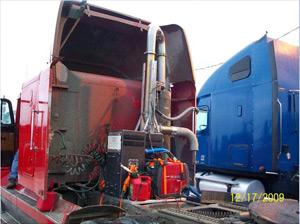 Technology to capture emissions data was temporarily installed on vehicles for this study.
Technology to capture emissions data was temporarily installed on vehicles for this study.Mobile sources contribute significantly to concentrations of air contaminants, including particulate matter. EPA’s National Vehicle and Fuel Emissions Laboratory collaborated with the Houston-Galveston, Texas area to investigate heavy-duty vehicle pollutants.
The partners studied heavy-duty drayage vehicles used at ports to determine their emissions contribution. Over 40 vehicles were studied in-depth for both emissions as well as activities.
EPA signed a Cooperative Research and Development Agreement (CRADA) with the Houston-Galveston Area Council, in cooperation with the Texas Commission on Environmental Quality. The collaborators also worked with the Port Authority of Houston to improve data on the amount of time vehicles were in the port area.
EPA reviewed and analyzed emission data on the heavy-duty vehicles to verify EPA’s emission modeling system - Motor Vehicle Emission Simulator (MOVES). This system captures emission factors for model year (MY)1990 through MY2006. EPA will use the data collected in the CRADA to update the latest version of MOVES.
EPA analyzed over 18 months of terminal visit data from two terminals within the Port of Houston. The average trip length (defined by “key on/off”) was 10 miles in length for 66% of all trips. EPA found that very few trucks were visiting these port terminals on a regular basis and were doing other local short-hauling work.
The partners analyzed data on the vehicle operating modes between port and non-port activity and found the results very consistent over four port terminals visited during this test program. They considered idle, creep, transient, and cruise for the vehicle operating modes.
The results from the four ports showed: The results from non-port activities showed: 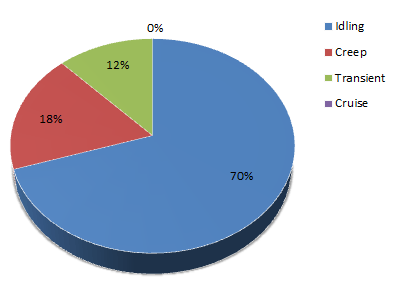
Idling: 70%; Creep: 18%; Transient: 12%; Cruise: 0%
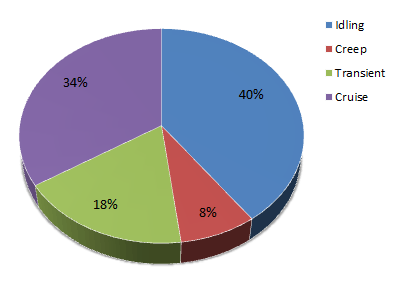
Idling: 40%; Creep: 8%; Transient: 18%; Cruise: 34%
Port visits lasted approximately 48 minutes. Most of the trucks visited in the morning hours and during the work week. These analyses help the Houston-Galveston Area Council gain a clearer picture of the contributions of port vehicles to overall air emissions.
EPA established a more thorough, statistically accurate sampling methodology for heavy-duty vehicles during this project. Other geographic locations with heavy-duty vehicles and port usage could apply this improved methodology to determine emissions contributions to the local area.
As EPA’s models are enhanced to include more real-world data, states can better anticipate how they will comply with National Ambient Air Quality Standards (NAAQS).
- Portable Saturation Sampler Measures Air Quality in Various Settings
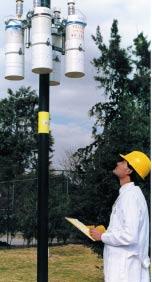 The inexpensive, low-volume sampler is used in a broad variety of sampling environments by virtue of its compact, lightweight, portable, weatherproof and rugged design.
The inexpensive, low-volume sampler is used in a broad variety of sampling environments by virtue of its compact, lightweight, portable, weatherproof and rugged design.The saturation sampler is an outstanding example of a collaborative development that is reaching the international marketplace and serving air monitoring needs worldwide. Numerous research efforts have incorporated this advanced air sampling technology. These efforts range from monitoring indoor air quality to responding to catastrophic events.
More than 3,200 samplers have been sold domestically and internationally, with total revenues exceeding $6 million. International clients purchase approximately half of the 200-400 samplers sold annually.
In the mid-1990s, EPA and the Lane Regional Air Pollution Authority in Oregon co-developed the saturation sampler. It reflects a unique integration, expansion and implementation of existing technologies. A U.S. patent was awarded for its ability to collect both filter and whole air samples in simultaneous, overlapping or individual monitoring regimes.
The inexpensive, low-volume sampler is used in a broad variety of sampling environments by virtue of its design elements. It is:
- Compact
- Lightweight
- Highly portable
- Weatherproof
- Rugged
The saturation sampler is used by private and public sector entities in a wide array of applications worldwide, including:
- Informing the development and verifying the performance of air quality dispersion models.
- Developing air emissions permits and monitoring compliance.
- Conducting occupational and indoor air quality studies.
- Conducting exposure, epidemiological, and air toxics studies.
- Performing surveillance on airborne hazards to military personnel (e.g., at deployments in Afghanistan and Iraq).
- Responding to emergencies (e.g., measuring impacts in the aftermath of the World Trade Center attack, Gulf War/Kuwait oil well fires and volcanic eruptions).
- Evaluating and informing the design of fixed monitoring air monitoring networks and programs.
- Concentrated Water Sampling Technology Rapidly and More Accurately Detects Contaminants
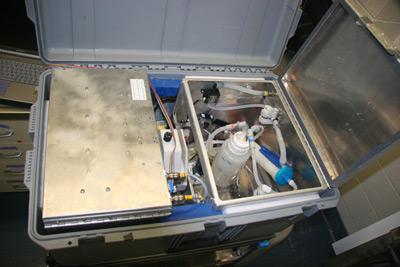 The water sample concentrator is constructed out of readily-available parts, and is easily portable.
The water sample concentrator is constructed out of readily-available parts, and is easily portable.The contamination of drinking water with pathogenic microorganisms is a public health concern. This concern leads to the need to rapidly and effectively sample water to detect small concentrations of potentially dangerous microorganisms.
Historically, analysis of water for the presence of low levels of microorganisms has required collection of a large volume sample. The sample is then transported to a laboratory where it is concentrated before analysis. Samples need to be concentrated because low levels of microbes can be more accurately detected in a concentrated sample than in a diluted one.
Alternatively, a technician can concentrate the sample in the field with cumbersome and delicate laboratory equipment.
In response to these challenges, EPA partnered with the Department of Energy’s Idaho National Laboratory (INL) to develop an ultrafiltration device. It is a rugged and automated field-deployable sample concentration device. The device significantly reduces the sample volume by concentrating the microorganisms into a small volume of water. The device can concentrate microbes in a 26 gallon sample into less than 2 cups of water, in less than an hour.
Following concentration, the smaller, concentrated sample can be more easily transported to a laboratory. The technology has a U.S. patent pending. The Centers for Disease Control and Prevention, the U.S. Geological Survey, and water utilities in Connecticut and Oregon have all used the device.
The water sample concentrator can also be used by water utilities during their routine regulatory compliance sampling. The technology can be used to sample:
- Bilge water on shipping vessels.
- Process control liquids from the brewing and pharmaceutical industries.
- Surface water for environmental studies.
- Decontamination water from cleanup areas.
- EPA and Industry Partners Apply Hybrid Technology to Port Vehicles
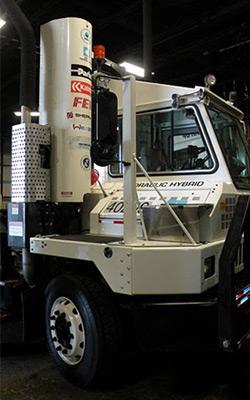 EPA and industry partners apply hybrid vehicle technology as part of EPA’s national clean diesel campaign’s clean ports program.
EPA and industry partners apply hybrid vehicle technology as part of EPA’s national clean diesel campaign’s clean ports program.EPA and its industry partners developed a leading-edge, pollution-saving truck for transferring cargo containers. They applied EPA’s patented series hydraulic hybrid vehicle (HHV) technology to the heavy-duty truck.
EPA and its partners then moved this series hydraulic hybrid yard hostler into field testing at port terminals in the U.S. Hostlers are large, off-road vehicles used to transfer cargo containers at:
- Marine ports
- Rail yards
- Warehouses
- Distribution centers
The trucks spend about half of their time idling and contribute to air pollution generated in ports throughout the world.
EPA’s unique series HHV power train efficiently recovers, stores and reuses braking power. At the same time, the technology significantly reduces idling and optimizes engine operation to use less fuel and reduce air pollution.
HHV technology has been demonstrated and field tested in a number of vehicles, including package delivery vehicles. EPA believes this vehicle design can improve the efficiency of the yard hostler operation by 50-60%.
EPA program collaborators included:
- The National Clean Diesel Campaign (NCDC) and its Clean Ports USA
- Clean Automotive Technology
- Office of International Affairs
- EPA Region 2 (New York and New Jersey)
Industry technical partners included:
- APM Terminals
- Parker-Hannifin
- Kalmar Industries
- FEV Inc.
- R. H. Sheppard Co Inc.
- Webasto
- The Port Authority of New York
- The New Jersey Department of Environmental Protection
Reducing emissions from diesel engines is one of the most important air quality challenges facing the country today. NCDC includes innovative programs to address the millions of diesel engines already in use as well as regulatory programs to address new diesel engines.
EPA’s Clean Automotive Technology Program conducts innovative research primarily to:
- Achieve ultra-low pollution emissions
- Reduce greenhouse gases
- Increase fuel efficiency
By developing cost-effective technologies, the Clean Automotive Technology Program also encourages manufacturers to produce cleaner and more fuel-efficient vehicles.
- National Clean Diesel Campaign (NCDC)
- NCDC's Ports & Marine webpage
- EPA's ports initiative
- EPA's Clean Automotive Technology program Search EPA Archive
- EPA's ToxCast Program Prioritizes Toxicity Testing of Environmental Chemicals
In 2007 EPA launched ToxCast™ to develop a cost-effective approach for prioritizing toxicity testing of many chemicals in a short time period. ToxCast™ uses data from high throughput screening (HTS) bioassays developed in the pharmaceutical industry. Using that data, ToxCast™ builds computational models to forecast the potential human toxicity of chemicals.
These hazard predictions provide EPA regulatory programs with science-based information that is helpful in prioritizing chemicals for more detailed toxicological evaluations. It also leads to more efficient use of animal testing.
When EPA launched ToxCast™ in 2007, it announced collaborative opportunities to facilitate and expand the development of ToxCast™. In Phase 1 of the ToxCast™ program alone, EPA executed over 20 Federal Technology Transfer Act (FTTA) agreements.
Working with these partners expands high-throughput bioassay data results on over 300 well-characterized chemicals in over 400 HTS endpoints. Most of these chemicals are pesticides. These endpoints include:
- Biochemical assays of protein function.
- Cell-based transcriptional reporter assays.
- Multi-cell interaction assays.
- Transcriptomics on primary cell cultures.
- Developmental assays in zebrafish embryos.
Almost all of the compounds examined in Phase 1 of ToxCast™ have been tested in traditional toxicology tests, including:
- Developmental toxicity
- Multi-generational studies
- Sub-chronic and chronic rodent bioassays
ToxRefDB, a relational database created to house this information, will contain nearly $1 billion worth of toxicity studies in animals when completed.
EPA will screen additional compounds representing broader chemical structure and use classes during the second phase of ToxCast™. This allows EPA to evaluate the predictive bioactivity signatures developed in Phase 1.
ToxCast™ will provide EPA regulatory programs with an efficient tool for rapidly and efficiently screening compounds and prioritizing further toxicity testing. EPA's National Center for Computational Toxicology (NCCT) continues to expand ToxCast™ with information shared through FTTA agreements.
- DNA-Based Innovation To Identify Molds and Bacteria
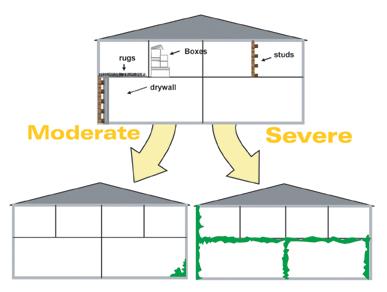 Testing for molds with EPA’s DNA-based technology may show if a structure is contaminated with molds and fungi, and to what degree.
Testing for molds with EPA’s DNA-based technology may show if a structure is contaminated with molds and fungi, and to what degree.Mold (i.e., fungi) in homes, schools and businesses can cause numerous health problems in the United States. EPA researchers developed a new technology to identify these mold-related problems quickly and accurately. This can lead to more effective diagnosis and treatment of related illnesses. Use of this technology may also prevent disease occurrence.
EPA’s DNA-based process can identify and quantify more than 130 species of toxic molds and potentially pathogenic fungi in the environment. Fungi and bacteria cause or contribute to many health problems, including:
- Infections
- Gastroenteritis
- Ulcers
- Asthma
- Allergies
- Sinusitis
EPA's invention may have applications in research related to therapeutics and diagnostics for these illnesses. Additionally, this technology can be used to:
- Determine whether an environment is abnormally contaminated with mold.
- Test homes and water for pathogenic molds.
- Monitor hospitals to prevent nosocomial mold infections.
- Rapidly diagnose mold infections so that treatment can begin earlier.
- Monitor food and drugs for mold contamination.
- Measure the risk for mold associated with allergic and asthmatic disease.
- Diagnose chronic rhinosinusitis.
- Monitor crops for mold pathogens in an integrated pest management program, thereby reducing the use of pesticides.
This method provides real-time results that are more accurate and less time consuming than current technologies. EPA licensed this technology to several commercial laboratories in the U.S. and the European Union to provide diagnostic services for their clients.
- Identifying Wood-Fired Heaters with Lowest Emissions
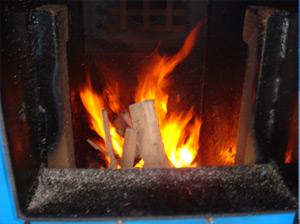 EPA and NYSERDA tested residential wood-fired heaters with various fuels to determine emissions.
EPA and NYSERDA tested residential wood-fired heaters with various fuels to determine emissions.EPA and the New York State Energy Research and Development Authority (NYSERDA) conducted a research project to evaluate wood-fired residential hydronic heater technologies. Using a Cooperative Research and Development Agreement (CRADA) the partners characterized:
- Emissions
- Health impacts
- Energy market penetration
EPA and NYSERDA looked at several types of residential wood-burning technologies. They evaluated and characterized the technologies for a variety of emissions under realistic, homeowner operation scenarios. The partners used EPA's combustion laboratories in Research Triangle Park, North Carolina for the research. They evaluated the following types of technologies:
- A common hydronic heater
- A high-efficiency pellet heater
- A unit with thermal storage
They tested three fuel types:
- Red oak
- White pine
- Red oak with supplementary household refuse
EPA and NYSERDA measured:
- Emissions of particulate matter
- Elemental carbon
- Carbon monoxide
- Polycyclic aromatic hydrocarbons (PAHs)
- Volatile organic compounds (VOCs)
- Semi-volatile organic compounds (SVOCs)
- Polychlorinated dibenzodioxins/dibenzofurans (PCDDs/Fs)
The partners completed an analysis of energy and market impacts of hydronic heaters for the State of New York. Lastly, they evaluated the health effects of hydronic heater emissions with an exposure study for pulmonary and systemic biomarkers of injury and inflammation.
Results of this study will assist New York in developing a high-efficiency biomass heating market of technologies with lower emissions. These results will also help EPA as it sets New Source Performance Standards for biomass-fired hydronic heaters.
EPA and NYSERDA have published several documents on the results of this study. Additionally, New York State is conducting follow-up research.
